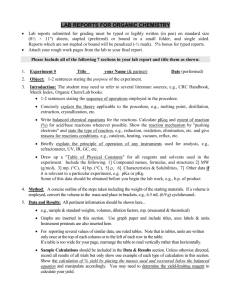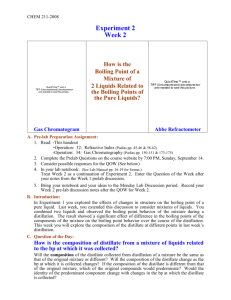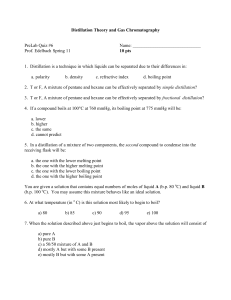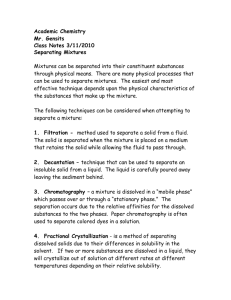experiment 7 distillation prelab assignment 1. 2
advertisement
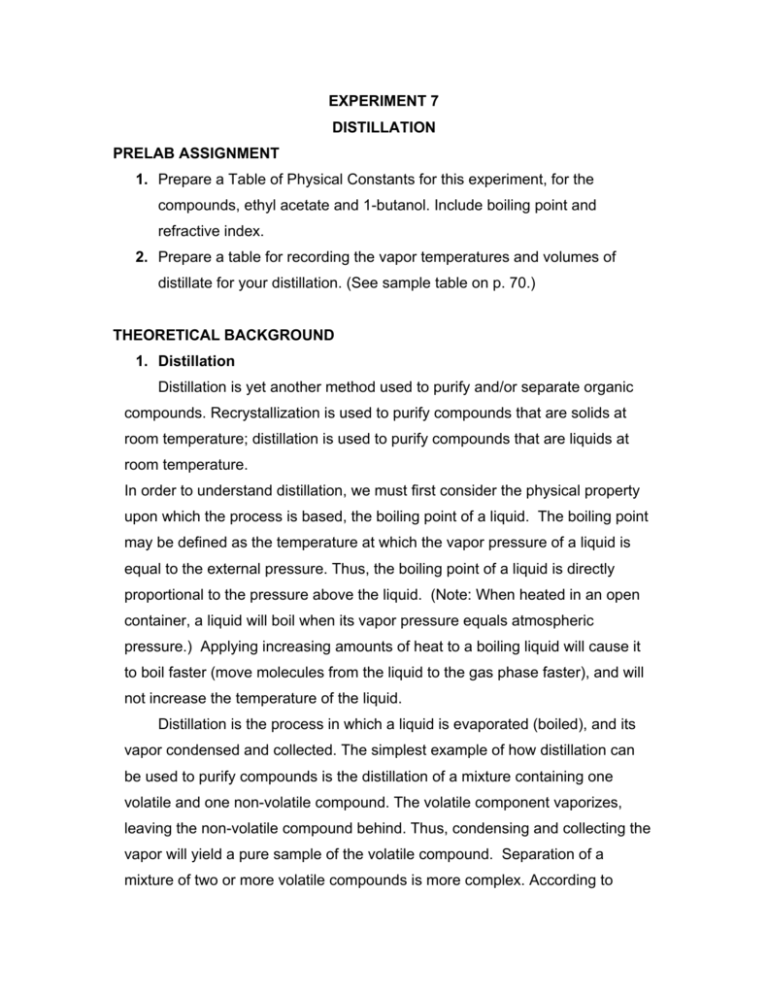
EXPERIMENT 7 DISTILLATION PRELAB ASSIGNMENT 1. Prepare a Table of Physical Constants for this experiment, for the compounds, ethyl acetate and 1-butanol. Include boiling point and refractive index. 2. Prepare a table for recording the vapor temperatures and volumes of distillate for your distillation. (See sample table on p. 70.) THEORETICAL BACKGROUND 1. Distillation Distillation is yet another method used to purify and/or separate organic compounds. Recrystallization is used to purify compounds that are solids at room temperature; distillation is used to purify compounds that are liquids at room temperature. In order to understand distillation, we must first consider the physical property upon which the process is based, the boiling point of a liquid. The boiling point may be defined as the temperature at which the vapor pressure of a liquid is equal to the external pressure. Thus, the boiling point of a liquid is directly proportional to the pressure above the liquid. (Note: When heated in an open container, a liquid will boil when its vapor pressure equals atmospheric pressure.) Applying increasing amounts of heat to a boiling liquid will cause it to boil faster (move molecules from the liquid to the gas phase faster), and will not increase the temperature of the liquid. Distillation is the process in which a liquid is evaporated (boiled), and its vapor condensed and collected. The simplest example of how distillation can be used to purify compounds is the distillation of a mixture containing one volatile and one non-volatile compound. The volatile component vaporizes, leaving the non-volatile compound behind. Thus, condensing and collecting the vapor will yield a pure sample of the volatile compound. Separation of a mixture of two or more volatile compounds is more complex. According to Raoult’s Law, the partial pressure of a liquid in the vapor above a solution is equal to the vapor pressure of the pure liquid times its mole fraction in the solution (P1 = P0X1). The total pressure above a mixture of miscible liquids is equal to the sum of the partial pressures of each of the liquids (PT = P01X1 + P02X2 + …). Since the vapor pressure of a liquid is inversely proportional to its boiling point, the vapor above a mixture of two miscible liquids contains a higher proportion of lower boiling component than did the original mixture. (Consider a solution containing 50% A, b.p. 75°C + 50% B, b.p. 100°C. When the solution is heated to its boiling point, the vapor above the boiling mixture will contain >50% A and <50% B, therefore, the ratio of A:B will be higher in the vapor than in the original solution.) Consequently, as the vapor is removed by distillation, the liquid mixture becomes increasingly richer in the higher boiling component, and its boiling temperature rises. If the vapor above the boiling liquid were condensed and revaporized, it would produce new vapor, which was even richer in the lower boiling component than the first vapor. An infinite series of these vaporizations, condensations, and revaporizations would eventually lead to a vapor that contained only the lower boiling component. If the lower boiling point component could be selectively removed as it is formed by this process, the two liquids could be separated. In practice, it is not necessary to repeat several separate distillations, because the process called fractional distillation accomplishes multiple distillations in one mechanical step. In a fractional distillation, the mixture of liquids is heated to boiling in the distilling flask (pot). The vapor rises up the fractionating column until it hits a cool surface provided by the packing. The vapor cools, condenses, and begins to run down the column. While this is occurring, heating of the pot continues. Since the vapor removed at first was richer in the lower boiling component, the mixture in the pot has become richer in the higher boiling component, so its boiling point is higher and the temperature of the new rising vapor, #2, is hotter than that of the first vapor, #1. This new rising vapor, #2, hits the condensed vapor, #1, and transfers heat, causing #1 to boil, forming new vapor #3, which is now the richest of all in the lower boiling component. Vapor #3 rises in the column where it hits a new cool surface, condenses, starts down the column where it is “greeted” by hotter vapor; it revaporizes, rises further in the column, and so on. In this way, a temperature gradient is established along the column, with the hottest temperatures at the bottom (richest in high boiling compound) and increasingly cooler temperatures toward the still head (richest in lower boiling compound). Eventually, when the purest sample of the lower boiling component reaches the still head (where the thermometer is located), it enters the condenser and is collected. A plot of the stillhead temperature (temperature of the vapor about to be condensed) vs. mL of distillate collected for distillations of various efficiencies is shown in Figure 1. Temperature B.Pt.B ----- Ideal Distillation Fractional Distillation ___ Simple Distillation B.Pt.A Volume of Distillate Figure 1 In an ideal distillation, all of the lower boiling component distills at its boiling point, then the vapor temperature rises sharply to the boiling point of the higher boiling component and it distills. If the collecting flask is changed when the temperature rises suddenly, the components will be collected separately, giving a perfect separation! In a fractional distillation, the early distillate distills at a temperature a bit above the boiling point of the lower boiling component. The last distillate comes over at a temperature slightly below the higher boiling component. Liquid mixtures boil at temperatures between the boiling points of the components. In a simple distillation, the initial temperature is higher and the final temperature is lower than in the fractional distillation. Also, note that temperature rise is much more gradual than in the fractional distillation. Non-ideal solutions Although most homogeneous liquid mixtures behave as ideal solutions, there are many examples known in which the behavior is non-ideal. In these solutions, the dissimilar molecules are not indifferent to one another’s presence. The resultant deviations from Raoult’s Law occur in either of two directions. Some solutions display greater vapor pressures than expected and are said to exhibit positive deviation. Others display lower vapor pressures than expected and are said to exhibit negative deviation. 2. Refractive Index When light passes from one substance into another it is refracted (bent). This occurs because the velocity (speed) of light changes as the light passes from one substance into another. The extent of the bending of the light rays depends upon the difference between the velocities of the light (V1 and V2) in the two substances (S1 and S2), and these two velocities are characteristic of the materials making up the two substances. Light ray S1 Interface between S1 and S2 S2 Figure 2 The relative refractive index (R) between two substances is defined by equation (1): V1 R = — V2 (1) This value (R) is characteristic of the two substances being compared. When the first substance is actually nothing at all (a vacuum), then V = c, the velocity of light in a vacuum, and R = 2, the absolute refractive index of substance 2, equation (2). c 2 = — V2 (2) Since the velocity of light in air is very close to c, the relative refractive index for air vs. a liquid is assumed to be equal to the absolute refractive index for the liquid. Vair 2 R = -------V2 (3) As stated earlier, _ for a liquid is characteristic of the substances that make up the liquid. Each pure liquid compound has a characteristic _. The refractive index, _, depends upon the temperature. The handbooks give _ at a particular temperature. To compare your values of _ to the literature values, you may have to apply a temperature correction. The corrected value for the refractive index can be calculated using the following equation: corrected = observed + 0.00045 x (t – 25.0) Mixtures of two compounds have _’s which are related to the _’s of the individual compounds and to the mole % of each compound in the mixture. Often _’s of a mixture exhibit a nearly linear relationship with the mole %. (See Figure 3.) Figure 3 Thus, if the refractive indices of the two components 1 and 2 of a mixture are known, the mole % composition of the mixture can be estimated from a plot such as Figure 3. For the mixtures of 1-butanol and ethyl acetate which will result from the distillation experiments, the _ vs. mole % curve deviates significantly from linearity. Consequently, an experimentally determined curve, which should give results that are accurate to with 1 %, is given in Figure 6. Use this calibration curve in analyzing your refractive index data. 3. Gas Chromatography (GC) (Vapor Phase Chromatography--VPC) As you learned in the TLC experiment, chromatography is a general method for separating a mixture of two or more components and obtaining each of the components in a pure state. All types of chromatography utilize a two-phase system, consisting of a mobile phase and a stationary phase. Generally, the mixture to be separated is applied to one end of the stationary phase and carried through the system by the mobile phase. The system is chosen such that the components of the mixture have different affinities for the stationary and mobile phases. Thus, as the mobile phase carries the mixture over the stationary phase, the components of the mixture reach different equilibria between the stationary and mobile phases, and are “washed” through the system at different rates. If the composition of the mobile phase is analyzed as the mobile phase exits the system, different results will be obtained as time passes. If a mixture of Compounds A, B and C is applied to the chromatography system and the composition of the exiting mobile phase is monitored over time, the following would be found: (a) Initially, the mobile phase would consist only of the mobile phase component (gas or liquid). (b) After a few minutes, Compound A would be detected. (c) As time passes, Compound A would decrease in amount and then Compound B would be detected. (d) At later times, Compound B would decrease in amount and finally Compound C would be detected. The lapse in time from the injection of a compound to its exit from the column is called its “retention time.” Each compound has a characteristic retention time, which depends upon the length of the column, carrier gas flow rate, the temperature of the column, injection block temperature, and the nature of the stationary phase. In GC, as the name suggests, the mobile phase is a gas (usually N2, He, Ne, or Ar). The stationary phase is either a solid, or more often a liquid that is coated on solid particles. Usually, the stationary phase particles are packed into glass or stainless steel tubing and the mobile gas phase (carrier gas) flows through the tubing. This packed tubing is called the chromatography “column.” As the gas passes out of the column, it flows through a detecting device, which senses the ability of the gas to conduct heat. When compounds other than the carrier gas are present, the conductivity of the gas mixture increases and the detector sends an increased signal to a recorder. The results of a separation such as that described for compounds A, B, and C is shown in Figure 4. A B C Time Figure 4 The relative amount of each component (A, B, or C) can be determined by calculating the area under the peak corresponding to each component and applying an appropriate sensitivity factor for the ability of the detector to sense each compound. A simple and reasonably accurate method for determining the areas of peaks is to treat them as symmetric triangles. Using this method, the area of a peak is calculated by first measuring its vertical height and then the width of the peak at half its height. The area is the product of the height and the width at half-height. A B 3.0 cm 1.0 cm C 1.0cm 2.0 cm 1.4 cm Figure 5 1.4 cm Peak Height (cm) Width at _ height Area (cm2) (cm) A 3.0 1.0 3.0 B 1.4 1.0 1.4 C 2.0 1.4 2.8 The Mole % of each component can be determined as follows: (1) Multiply the areas by the appropriate molar sensitivity factors to get the corrected areas. (2) Calculate the % that each corrected area is of the sum of the corrected areas. (Note: Sensitivity factors are experimentally determined.) Peak Area (cm2) Molar Corrected Sensitivity Areas (cm2) Mole % Factor A 3.0 0.95 2.85 42.5 B 1.4 1.25 1.75 26.1 C 2.8 0.75 2.10 31.3 Total 6.70 Thus, the original mixture consisted of 42.5% A, 26.1% B, and 31.3% C. GENERAL PROCEDURES 1. Boiling Points As with melting points, an experimentally determined boiling point is actually a range of temperatures. An acceptable boiling range for a pure compound is 3 ºC. Samples with wider ranges should be redistilled to improve purity. 2. Thermometer Placement and Insulation of the Stillhead Accurate measurement of the temperature of the distillate requires that the thermometer bulb be completely immersed in the vapor that is moving into the condenser. If the thermometer bulb were very small, and no heat loss occurred through the glass of the stillhead, the ideal position for the thermometer is directly opposite the sidearm that leads to the condenser. The thermometer is placed such that the upper edge of the bulb is even with the lower edge of the sidearm. This placement of the thermometer assures that the bulb will be completely immersed in the vapor. If the thermometer is placed too high in the stillhead, its bulb may be only partially immersed in the vapor resulting in an experimental temperature which is lower than that of the distillate being collected. If the thermometer is placed too low in the stillhead, its bulb will be immersed in vapor further down the column than the vapor that is entering the condenser, resulting in an experimental temperature that is higher than that of the distillate being collected. 3. Notes on the Assembly of Ground Glass Equipment a. Do not grease the joints. (Grease is needed only for vacuum work or when basic compounds are used.) b. Avoid breakage. The correct positions for clamps are at the top of the distillation flask, just under the flare. Use gentle pressure on the clamps to avoid cracking the flask or condenser. (Use rubber liners or pieces of paper on the clamps.) c. Check the demonstration set-up for proper placement of the thermometer. (See discussion above.) d. Rubber tubing should be moistened with water, and firmly attached to the condenser and the water faucet. Think about why water is led into the bottom of the condenser. The exit water is led into the cup sink in the hood. A clamp holder loosely attached to the rubber exit tube will help to keep it from slipping out of the sink whenever you turn on the water. When turning on the water, hold the exit tube with your other hand so that you can adjust the water to the correct pressure. There should be only a moderate stream of water. By convention, all water and steam valves turn on counter-clockwise, and off clockwise. e. Have your instructor check your apparatus before you start your distillation. EXPERIMENTAL PROCEDURE Fractional Distillation During this period, you will carry out the separation of 30 mL of a 1:1 mixture of ethyl acetate and 1-butanol using a fractional distillation apparatus. 1. Preheat a heating mantle without a flask for 5 min. at 100 volts. Allow it to cool for 5 min. before beginning your distillation. 2. While your mantle is preheating, assemble your fractional distillation apparatus. (See the demonstration set-up.) Have ready three 25 mL graduated cylinders with stoppers to fit the cylinders. Label the cylinders F1, F2, and F3. 3. Obtain 30 mL of the distillation mixture, and pour it into a 50 mL round bottom flask. Add a magnetic stir-bar and attach the flask to your distillation apparatus. When you believe that you are completely prepared to begin the distillation, have your apparatus checked by an instructor. Then turn on the condenser cooling water. 4. After your apparatus has been checked, begin heating the distilling flask at 80 volts. 5. When the mixture begins to boil, follow the position of the upper condensing vapor as it moves into the stillhead. When the vapor reaches the thermometer bulb, the temperature reading should rise rapidly to value near the boiling point of ethyl acetate. (See your Table of Physical Constants.) 6. Record the temperature of the vapor when the first drop of distillate is collected in your graduated cylinder. Consult your instructor if this temperature is (1) below the b.p. of ethyl acetate or (2) more than 5°C above the b.p. of ethyl acetate. Your thermometer may be improperly placed. (See the discussion in section C.2.) 7. Adjust the voltage setting of the Variac so as to yield a collection rate (distillation rate) of approximately 1 drop per second. As the distillation progresses, the voltage setting may need to be raised in order to maintain the distillation rate at 1 drop per second. Record the vapor temperature after each mL of distillate has been collected. 8. When the vapor temperature has risen 5°C above the b.p. of ethyl acetate, switch to the second graduate cylinder. The first cylinder contains Fraction (cut) F1. Stopper it promptly to prevent evaporation. 9. Continue recording vapor temperatures after collection of each mL of distillate. 10. When the vapor temperature rises to a point 5°C below the boiling point of 1butanol, switch to the third graduate cylinder. Stopper the second graduate cylinder, which contains Fraction (cut) F2. 11. Continue recording temperatures as before. Discontinue the distillation when a total of 26 mL of distillate has been collected. If the temperature begins to decrease at this point, consult an instructor. The distillate collected during the last part of the distillation is fraction (cut) F3. Stopper the cylinder at the end of the distillation. 12. Be sure to record the volumes and temperature ranges of all three fractions in a table. (See sample table.) 13. Determine the refractive index of each of your distillation fractions. (This procedure will be demonstrated by an instructor.) 14. Discard all three fractions in the waste bottle in the hood. E. ANALYSIS OF RESULTS 1. Plot vapor temperature vs. distillate volumes for your fractional distillation on a graph. This graph should be attached to your notebook on a right-hand page in your Results section, immediately after the data tables. On your graph, indicate the segments corresponding to pure ethyl acetate, pure 1-butanol, and mixture. 2. Determine the mole %’s of each compound in each of the distillation fractions from your Refractive Index values using Figure 6. (It is not necessary apply the temperature correction if the R.I.’s were measured between 24-26 º C. For values measured at temperatures outside this range, use the equation on p.61.) Display the R.I. and mole % result in your Distillation Results Table (as shown). 3. Do your refractive index results agree with the shape of your plot of the distillate temperatures? Explain briefly. 4. Figure 7 gives both sample GC and refractive index data for a fractional distillation from this experiment. a. From the GC data and from the refractive index data, determine the mole % of ethyl acetate and 1-butanol in each fraction. Display your calculated results in a table, as shown on p. 70. (Show your GC calculations.) b. Considering that both analytical methods should be accurate to within 1% for the major component, do the results of the two methods agree? Explain in two sentences or less. If they do not agree, give a plausible explanation. c. Enter your fractional distillation results in the lower left-hand section of the table described in a above. How does the quality of your fractional distillation compare with the results shown in Figure 7? Explain in a few sentences. F. QUESTION 1. Three mixtures of ethyl acetate and 1-butanol have the following refractive indices. Determine the Mole %’s of ethyl acetate and 1-butanol in each of the three samples. (See Figure 6.) (a) 1.3760 (b) 1.3890 G. DISCUSSION AND CONCLUSIONS (c) 1.3954 Sample Tables for Vapor Temperatures and Volumes of Distillate for Fractional Distillation Volume vs. Temperature for a 1:1 Mixture of Ethyl Acetate and 1-Butanol Volume B.P. (º C) 1 drop 1 mL 2 mL 3 mL . . . Total = 26 mL Distillation Results Fraction # Volume, mL Boiling Range R.I. Mole% EtOAc Mole% 1-BuOH F1 F2 F3 VPC and RI %’s (Question E4) Fraction # Older Data (Figure 7) F1 F2 F3 Your Expt. F1 F2 F3 25 nD nD Mole %’s EtOAc 1-BuOH VPC Corrected Areas EtOAc 1-BuOH VPC Mole %’s EtOAc 1-BuOH



